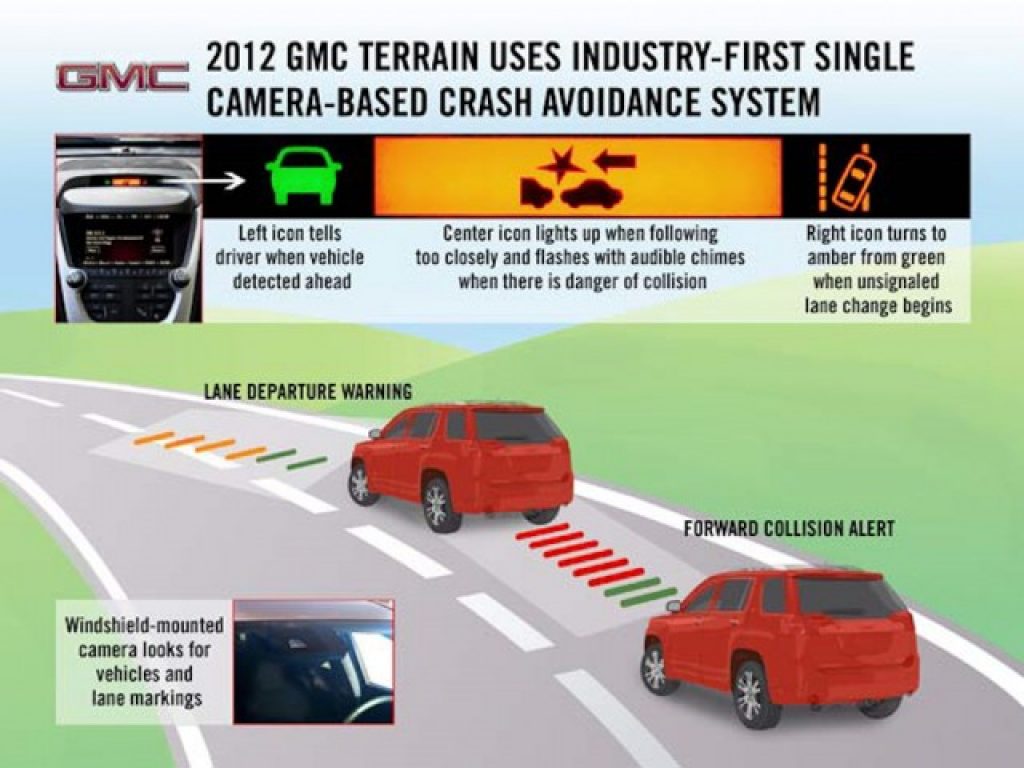Mid-month, I mentioned that the U.S. government was considering mandating the inclusion of rear-view cameras in all vehicles, and I pondered what sort of beyond-backup-view applications engineers might find for the resultant image sensors, processors and other circuitry. The case for front-mounted image subsystems has historically been less solid, however.
For one thing, the driver's eyes are already pointed at the road ahead of the vehicle, whereas (with the possible exception of the occasional mother) eyes aren't generally located in the back of the head. And for another, visible-spectrum visual discernment, unlike (for example) radar, can be obscured by fog, rain, snow and other weather phenomenon, not to mention the dark of night.
The combination of these factors explains why a recent writeup in Extremetech, "GMC adds in low-cost collision warning by using a cam instead of radar," caught my eye. GM is apparently using embedded vision as both a cost-reduction and feature-enhancement plan versus competitor Ford, which at least to date has standardized on radar-based systems. Not only does GM's technology implement impending-collision driver alerts, it also provides early warning of unintended lane departures:
GMC mounts a 14 frames-per-second video camera, forward-facing, inside the rear view mirror housing. Essentially it’s a webcam done to auto-grade specs (for temperature swing, vibration, and to outlast the warranty). In other vehicles this kind of camera just watches pavement markings and serves as a lane departure warning system, for which most automakers charge up to $400. For forward collision warning, the camera and image processor add a set of algorithms to identify vehicles ahead and calculate relative speeds.
The software looks for vehicle shapes and at night it also looks for tail lamp pairs. Four separate short and long exposures are combined, the short exposures for tail lamps, the long exposures for the vehicle shapes. Photographers call this high dynamic range (HDR) imaging. The shapes are tracked frame-to-frame for size (i.e. distance) changes and a time-to-crash calculation is updated. If the math isn’t in your favor, the escalating alerts kick in.
Reporter Bill Howard recently took the 2012 GMC Terrain, a midsized crossover that sells for $30,000-$35,000 and the first GM vehicle with the forward collision warning / lane departure warning combo, for a test drive. He was seemingly pleased with the outcome, both in an absolute sense and relative to prior-generation vehicles he'd auditioned:
How well does it work? Very well, as long as you understand you do the braking, not the car. I drove a GMC Terrain recently in winter conditions; GMC was also showing off the vehicle’s snow country attributes such as stability control, all-wheel drive, and winter tires. Forward collision warning starts at 25 mph and works when the windshield isn’t covered with grime; a flick of the wipers returns functionality to the system. On the dash, there’s a row of warning icons at the top of the center stack. The icon on the left lights up and glows green when it detects a car ahead. A larger yellow icon lights up when you’re too close.
When a collision seems likely, the yellow icon flashes, a chime beeps seven times, and the brakes are pre-charged for maximum force once you decide you will stop the car. GMC’s forward collision warning is simple, idiot-proof, and it works. This could be the best $295 you spend on your next vehicle. The simpler LDW (lane departure warning) system is less admirable because the alerts comprise an amber center stack warning icon (okay) and a three-beep warning chime (ill-informed). It works at 35 mph and up.
GM engineers weren’t paying attention when other automakers built their LDW systems. You don’t need to be a human factors Ph.D to know a chime or beep tells the passengers, “The driver screwed up,” and the driver is likely to respond by disabling the system. Lane departure warning (and blind spot detection) systems that lightly vibrate the steering wheel or, as Cadillac will do with its upcoming XTS sedan, vibrate the seat pan, are the way to go. GM needs to make a quick but urgent fix here, and follow it by moving the FCW / LDW cluster into the instrument panel or put it at the base of the windshield, as Ford does with its ACC / FCW system, for better driver sightlines. Audible alerts for collision warnings are okay because you don’t hear them as often and when you do, it’s serious.


